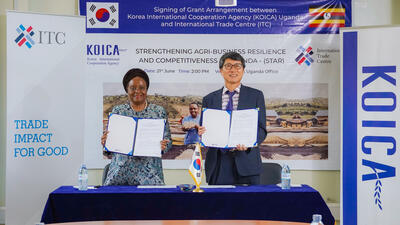



Artesanía de África encuentra la alta moda (en)
In the four years since ITC first approached the world’s biggest fashion houses to promote its Ethical Fashion Initiative, the programme has gone
from strength to strength. Starting from little more than a solid strategy and a selection of East African raw and reclaimed materials, the initiative is now providing sustainable employment to 12 core communities of producers in Kenya and Uganda —approximately 1,200 people — coordinated from a business and production hub in Nairobi. During peak periods, additional communities are involved, and one production surge saw 7,000 people working for the programme.
Part of ITC’s Poor Communities and Trade Programme and financed by Window I of the ITF, the initiative connects international fashion companies and distributors with micro-producers based in marginalized communities. Skilled workers who have not historically been part of the larger value chain are able to use their skills to create high-end products that can legitimately claim to be ethical.
Simone Cipriani, head of the Poor Communities and Trade Programme and Chief Technical Adviser for Ethical Fashion, attributes the programme’s success to a line of work that is wholly market-based. “There is a growing demand from consumers for fashion that is good to people and good to the environment. The initiative simply met this demand with the right products, and we put our trust in the women informal producers and workers of Africa.”
“The idea is that we want the communities we work with to become permanent suppliers, so it’s notreally about involving them in the design, or making the products ethnic, which might be fashionable for a season,” said Jeremy Brown, lead productdevelopment adviser for ITC’s Ethical Fashion Initiative.“Instead, we teach them how to manufacture well. In that way, we’re building something that can last.”
Winning with Westwood
In 2011, the Ethical Fashion team welcomed iconic British fashion designer Vivienne Westwood to its Nairobi hub — her first time at the site since her company began working with Ethical Fashion in 2008. Westwood met with artisans, led training workshops and learned about the local skills and communities as she developed her new collection with the women. As a result, Vivienne Westwood Ltd extended its commitment to producing accessories in Kenya, and increased its orders.
“We are not interested in just getting a cheap product,” said Christopher Di Pietro, Marketing and Merchandising Director for Vivienne Westwood Ltd. “What’s important is that it’s ethically made.”
Underscoring the success and long-term viability ofthe collaboration, Westwood’s 2011 Ethical Fashion Africa line has been nominated for the prestigious Best Design of the Year award by the Design Museum in London; winners will be announced in summer 2012.
Vivienne Westwood herself is looking for an even higher impact. Inspired during her visit to Kenya in June 2011, she commented, “It’s quite incredible to think that we might save the world through fashion.”
Not charity, just work.
The Ethical Fashion Initiative business model isnot only focused on making goods that marketsdemand, it also ensures that the women, who makeup about 90% of the workforce, gain skills that will serve them in the long term.
Major retailers are also realizing the businesspotential and corporate responsibility of sourcing products that are ethically made. The EthicalFashion Initiative is now working with American company Walmart, which is one of the biggest powers in retail sales, on plans for 2012 retail distribution of Ethical Fashion’s products.
Taking the programme west
Participants in the Ethical Fashion Initiative nowenjoy a steady flow of orders, well-established customer relationships, and capable and experienced staff. The ITC team is therefore turning its attention to West Africa — replicating the TRTA development model potentially to Ghana, Burkina Faso and Mali — and to Haiti.














